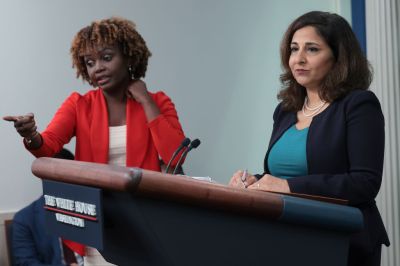The Biden administration recently announced a new move to exercise authority—known as “march-in” rights—to seize drug patents on costly medications. Its hope: manufacturing more drugs and getting them in the hands of consumers for lower prices.
The proposal allows the government to give third parties licenses if the original patent holder of certain inventions created with the use of government funding does not offer products at reasonable prices.
The authority covers more than just prescription drug patents, but for now the administration primarily plans to use it to evaluate which drugs could be subjected to patent seizure. “Patent and other laws have been misused to inhibit or delay for years and sometimes even decades competition for generic drugs and biosimilars, which overall denies Americans access to lower-cost drugs,” White House domestic policy adviser Neera Tanden said in a press briefing last week.
The unprecedented move, which will be up for discussion and comment until 5 p.m. on February, 6, 2024, has inflamed pharmaceutical manufacturers, while some consumer groups have praised the potential cost savings. Its implementation could have major implications for innovation in the pharmaceutical industry.
What gives the administration the authority to do this?
In 1980 Congress passed the Bayh-Dole Act, a measure to help the U.S. compete in the expanding global marketplace, specifically with Japan, and to help get the economy moving after the doldrums of the 1970s. In short, it allowed the private sector to retain patents for innovations that received federal funding. These recipients—which include businesses, universities, and nonprofits—had to abide by certain stipulations. Among them, the government retained its right to “march-in” if a product was not being offered to the market on “reasonable” terms.
Bayh-Dole sought to encourage small business innovation and increase competition. However, it never addressed the government enforcing reasonable prices, and Sens. Birch Bayh and Bob Dole stated in 2002 that “reasonable terms” was not a euphemism for price controls. Instead, they emphasized the need for price competition.
To determine when a licensee is not offering its product on “reasonable” terms, the federal government included four criteria in its framework: 1) if the exclusive licensee has not taken “effective steps” within a “reasonable time” to “achieve “practical application of the invention”; 2) if action is necessary to “alleviate health or safety needs”; 3) if action is necessary for “public use” according to federal regulations; and 4) if the licensee is not compliant with the requirement for domestic manufacturing, or it has not been waived.
More broadly, the framework poses several questions to determine whether the government should exercise march-in rights: “(1) whether Bayh-Dole applies to the invention(s) at issue; (2) whether any of the statutory criteria for exercising march-in applies under the circumstances; and (3) whether the exercise of march-in rights would support the policy and objectives of Bayh-Dole.”
Several federal statutes govern patents—including Article I of the Constitution and titles 35 and 37 of the United States Code—but controversy has arisen around loopholes that some manufacturers use to retain rights to their products. One example: the Federal Trade Commission’s current investigation into certain companies using the federal registry to list different components of a patent separately in order to delay the production of a generic version of the product. This review of the “Approved Drug Products with Therapeutic Equivalence Evaluations,” also known as the “Orange Book,” was announced in September 2023.
Still, Bayh-Dole has been in the books for more than 40 years, and it has never been used this way before. Although eight petitions to do so have been filed over the 40-plus years since this legislation was enacted, the government has not yet exercised its march-in rights.
The Biden administration appears clear-eyed about the potential consequences of taking these measures. In its proposed framework, it noted the move could have “potentially significant positive and negative ramifications,” and that in the past, federal agencies have “worked with the parties to find an alternative solution to achieve the desired objectives.”
What’s the government’s argument for doing this?
Essentially, the Biden administration wants to make prescriptions more affordable. Health care spending in the United States is climbing. Spending on prescription drugs increased by 76 percent from 2000 to 2017, according to the RAND Corporation. At $12,914 per person, health care spending in the United States is $5,000 more than in any other high-income country. Prescription drug prices in the United States are 2.56 times higher than those in 32 other countries. Three in 10 Americans say they find it “somewhat” or “very difficult” to afford prescription drugs, and another 3 in 10 say they have not taken drugs as prescribed due to cost.
“American taxpayers pay more for research than any country in the world: hundreds of billions of dollars on research relevant to developing new drugs through the [National Institutes of Health] and other agencies,” Tanden said at the press briefing last week. “But at the same time, pharmaceutical companies charge Americans two to three times—and sometimes even more than that—for the same drugs than what they can charge in other countries.”
What are the potential pitfalls?
Pharmaceutical companies will likely argue that such seizure of the patents is illegal and will disincentivize research and development and innovation—the opposite of the intended effect of Bayh-Dole.
Critics say the private sector may be hesitant to take risks and innovate if the government is able to march-in and control prices. According to the Information Technology and Innovation Foundation, using march-in rights to control prices would leave companies “highly reticent to license IP that could be connected to federal research and subsequently invest the additional billions required to develop a drug if they knew the government could come in as long as two decades later and seize or compulsorily license companies’ IP whenever it deemed a drug’s price too high.” As such it could discourage innovation by the private sector and hinder future efforts to develop new drugs to combat future pandemics, chronic disease, and other major issues of national concern and security.
In response, the government has stated that a goal of the framework is to account for “the need to incentivize industry investment in the development and commercialization of subject inventions” along with the “need to promote public utilization of subject inventions.” One caveat is that this measure applies only to drugs that receive government funding for the research and development, not drugs funded only by private sector money. Since a significant number of innovative therapies come from small biotech companies that receive funding from the government and nonprofits, this issue will affect pharmaceutical development and innovation. According to a July 2023 Nature paper, new drugs developed from the top 20 biopharma companies from 2015 to 2021 shows those companies “business model in recent years has largely been built on external innovation, as only 28% originated internally.”
Are drug companies chiefly responsible for the price of prescription drugs?
President Joe Biden may have laid blame for the high cost of prescription drugs squarely on drug companies, but payers and pharmacy benefit managers (PBMs) are integrally involved in drug pricing. The use of march-in rights will have no bearing on these players who affect the out-of-pocket costs that patients pay for medications. In addition, the PBM sector is highly concentrated, with 80 percent controlled by three large players— Express Scripts, CVS Caremark, and OptumRx (the pharmacy service segment of UnitedHealth Group Insurance).
In some cases, PBMs promote the use of medications with high list prices, avoid passing rebates along to patients, and use co-pay maximizers which counteracts the patient financial assistance provided by pharmaceutical manufacturers. There are currently two bipartisan bills in Congress addressing issues related to PBMs, including transparency for reimbursement, pricing, fee and mark-ups.






Please note that we at The Dispatch hold ourselves, our work, and our commenters to a higher standard than other places on the internet. We welcome comments that foster genuine debate or discussion—including comments critical of us or our work—but responses that include ad hominem attacks on fellow Dispatch members or are intended to stoke fear and anger may be moderated.
With your membership, you only have the ability to comment on The Morning Dispatch articles. Consider upgrading to join the conversation everywhere.